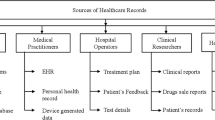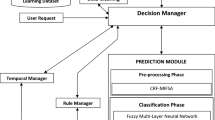Abstract
Crohn’s disease (CD) diagnosis is a tremendously serious health problem due to its ultimately effect on the gastrointestinal tract that leads to the need of complex medical assistance. In this study, the backpropagation neural network fuzzy classifier and a neuro-fuzzy model are combined for diagnosing the CD. Factor analysis is used for data dimension reduction. The effect on the system performance has been investigated when using fuzzy partitioning and dimension reduction. Additionally, further comparison is done between the different levels of the fuzzy partition to reach the optimal performance accuracy level. The performance evaluation of the proposed system is estimated using the classification accuracy and other metrics. The experimental results revealed that the classification with level-8 partitioning provides a classification accuracy of 97.67 %, with a sensitivity and specificity of 96.07 and 100 %, respectively.








Similar content being viewed by others
References
Alayon S, Gonzalez de la Rosa M, Fumero FJ, SigutSaavedra JF, Sanchez JL (2013) Variability between experts in defining the edge and area of the optic nerve head. Arch Soc Esp Oftalmol 88(5):168–173 (English edition)
Arifin AZ, Asano A, Taguchi A, Nakamoto T, Ohtsuka M, Tanimoto D (2005) Computer-aided system for measuring the mandibular cortical width on panoramic radiographs in osteoporosis diagnosis. In: Proceedings of SPIE medical imaging 2005, image processing conference San Diego, California, pp 813–819
Bagheri A, Adorno D, Rizzo P, Barraco R, Bellomonte L (2014) Empirical mode decomposition and neural network for the classification of electroretinographic data. Med Biol Eng Comput 52(7):619–628
Baumgart DC, Sandborn WJ (2012) Crohn’s disease. Lancet 380(9853):1590–1605
Benamrane N, Aribi A, Kraoula L (1993) Fuzzy neural networks and genetic algorithms for medical images interpretation. IEEE Proc Geom Model Imaging. doi:10.1109/GMAI.2006.20
Bisho CM (1995) Neural networks for pattern recognition. Clarendon Press, Oxford
Casanova JL, Abel L (2009) Revisiting Crohn’s disease as a primary immunodeficiency of macrophages. J Exp Med 206(9):1839–1843
Casteillo C, Castellano G, Caonetti L, Fa-Nelli AM (2003) Classifying image pixels by a neuro-fuzzy approach. In: Proceedings of the WISP 2003 conference
Castillo E, Guijarro-Berdinas B, Fontenla-Romero O, Alonso-Betanzos A (2006) A very fast learning method for neural networks based on sensitivity analysis. J Mach Learn Res 7:1159–1182
Chawla R, Ahlawat D, Kumar M (2014) Improved software development effort estimation based on fuzzy logic functions. Int J Eng Sci Res Technol 3(12):529–535
Cho JH, Brant SR (2011) Recent insights into the genetics of inflammatory bowel disease. Gastroenterology 140(6):1704–1712
Chowriappa P, Dua S, Todorov Y (2014) Introduction to machine learning in healthcare informatics. Med Biol Eng Comput 56:1–23
Cornaggia M, Leutner M, Mescoli C, Sturniolo GC, Gullotta R (2011) Chronic idiopathic inflammatory bowel diseases: the histology report. Dig Liver Dis 43:S293–S303
Dessein R, Chamaillard M, Danese S (2008) Innate immunity in Crohn's disease: the reverse side of the medal. J Clin Gastroenterol 1:S144–S147.doi:10.1097/MCG.0b013e3181662c90
Devlin HB, Datta D, Dellipiani AW (1980) The incidence and prevalence of inflammatory bowel disease in North Tees Health District. World J Surg 4(2):183–193
Evans JG, Acheson ED (1965) An epidemiological study of ulcerative colitis and regional enteritis in the Oxford area. Gut 6(4):311–324
Fernandes FC, Brasil LM, Lamas JM, Guadagnin R (2010) Breast cancer image assessment using an adaptative network based fuzzy inference system. J Pattern Recognit Image Anal 20(2):192–200
Folland R, Hines E, Boilot P, Morgan D (2002) Classifying coronary dysfunction using neural networks through cardiovascular auscultation. Med Biol Eng Comput 40(3):339–343
Frost F, Karri V, editors (1999) Performance comparison of BP and GRNN models of the neural network paradigm using a practical industrial application. In: Proceedings ICONIP’99 6th international conference on neural information processing, IEEE 1999
Fu X, Wang L (2003) Data dimensionality reduction with application to simplifying RBF network structure and improving classification performance. IEEE Trans Syst Man Cybern B Cybern 33(3):399–409
Fung CC, Iyer V, Brown W, Wong KW, editors (2005) Comparing the performance of different neural networks architectures for the prediction of mineral prospectivity. In: Proceedings of 2005 international conference on machine learning and cybernetics, IEEE 2005
Ghaderzadeh M, Fein R, Standring A (2013) Comparing performance of different neural networks for early detection of cancer from benign hyperplasia of prostate. Appl Med Inform 33(3):45–54
Haykin S (1994) Neural networks-a comprehensive foundation. Mac. Press, New York
Hong CM, Chen C, Chen SY, Huang CY (2006) A novel and efficient neuro-fuzzy classifier for medical diagnosis. In: IEEE international joint conference on neural networks, pp 735–714. doi:10.1109/IJCNN.2006.246757
Humphreys WG, Parks TG (1975) Crohn’s disease in Northern Ireland—a retrospective survey of 159 cases. Ir J Med Sci 144(11):437–446
Hwang S, Kim D, Kang T, Park G (2007) Medical diagnosis system of breast cancer using FCM based parallel neural networks. In: International conference on intelligent comput. Springer, pp 712–719
Istenič R, Kaplanis P, Pattichis C, Zazula D (2010) Multiscale entropy-based approach to automated surface EMG classification of neuromuscular disorders. Med Biol Eng Comput 48(8):773–781
Jiang X, Wah A (2003) Constructing and training feed-forward neural networks for pattern classification. Pattern Recognit 36:853–867
Joshi DM, Rana NK, Misra VM (2010) Classification of brain cancer using artificial neural network. In: International conference electronic computer technology, pp 112–116
Kaya M, Alhajj R (2003). A clustering algorithm with genetically optimized membership functions for fuzzy association rules mining. 12th IEEE international conference on fuzzy systems, vol 2, pp 881–886
Kodogiannis VS, Lygouras JN (2008) Neuro-fuzzy classification system for wireless-capsule endoscopic images. J World Acad Sci Eng Technol 45:620–628
Kumar A, Ghosh S, Tetarway S, Sinha R (2015) Support vector machine and fuzzy C-mean clustering-based comparative evaluation of changes in motor cortex electroencephalogram under chronic alcoholism. Med Biol Eng Comput 53(7):609–622
Kuncheva LI, Steimann F (1999) Fuzzy diagnosis. Artif Intell Med 16:121–128
Kyle J (1971) An epidemiological study of Crohn’s disease in Northeast Scotland. Gastroenterology 61(6):826–833
Kyle J, Stark G (1980) Fall in the incidence of Crohn’s disease. Gut 21(4):340–343
Lalande JD, Behr MA (2010) Mycobacteria in Crohn’s disease: how innate immune deficiency may result in chronic inflammation. Expert Rev Clin Immunol 6(4):633–641
Li Y, Chi Z (2005) MR brain image segmentation based on self-organizing map network. Int J Inf Technol 11(8):45–53
Maglinte DD, Gourtsoyiannis N, Rex D, Howard TJ, Kelvin FM (2003) Classification of small bowel Crohn’s subtypes based on multimodality imaging. Radiol Clin North Am 41(2):285–303
Maitrot A, Lucas M, Doncarli C, Farina D (2007) Signal-dependent wavelets for electromyogram classification. Med Biol Eng Comput 45:807
Marks DJ, RahmanFZ Sewell GW, Segal AW (2010) Crohn’s disease: an immune deficiency state”. Clin Rev Allergy Immunol 38(1):20–31
Mayberry J, Rhodes J, Hughes LE (1979) Incidence of Crohn’s disease in Cardiff between 1934–1977. Gut 20(7):602–608
Miller DS, Keighley AC, Langman MJ (1974) Changing patterns in epidemiology of Crohn’s disease. Lancet 2(7882):691–693
Nath S, Kar J, Chakraborty S, Mishra G, Dey N (2014) A survey of image classification methods and techniques. In: International conference on control, instrumentation, communication and computational technologies 2014, pp 554–557. doi:10.1109/ICCICCT.2014.6993023
Nawel Z, Azizi N, Sellami M, Dey N (2015) Automated classification of mammographic abnormalities using transductive semi supervised learning algorithm. Mediterranean conference on information & communication technologies 2015, May 7–9, 2015 Saïdia, Morocco
Nazzal JM, El-Emary IM, Najim SA (2008) Multilayer perceptron neural network (MLPs) for analyzing the properties of Jordan oil shale. World Appl Sci J 5(5):546–552
Oweis RJ, Sunna MJ (2005) A combined neuro-fuzzy approach for classifying image pixels in medical applications. J Electr Eng 56(5–6):146–150
Panchal R, Verma B (2004) A fusion of neural network based auto-associator and classifier for the classification of microcalcification patterns. In: International conference neural information processing, Springer Berlin, pp 794–799
Reddy S, Raju K (2009) Improving the accuracy of effort estimation through fuzzy set representation of size. J Comput Sci 5(6):451–455
Ross N, Pritchard C, Rubin D, Dusé A (2006) Automated image processing method for the diagnosis and classification of malaria on thin blood smears. Med Biol Eng Comput 44(5):427–436
Saraswat M, Arya K (2014) Feature selection and classification of leukocytes using random forest. Med Biol Eng Comput 52(12):1041–1052
Smith IS, Young S, Gillespie G, O’Connor J, Bell JR (1975) Epidemiological aspects of Crohn’s disease in Clydesdale. Gut 16(1):62–67
Tresadern JC, Gear MW, Nicol A (1973) An epidemiological study of regional enteritis in the Gloucester area. Br J Surg 60(5):366–368
Übeyli ED (2009) Adaptive neuro-fuzzy inference systems for automatic detection of breast cancer. J Med Syst 33:353–358
Virmani J, Dey N, Kumar V (2015) PCA-PNN and PCA-SVM based CAD systems for breast density classification. Applications of intelligent optimization in biology and medicine: current trends and open problems” to be published by Springer 2015
Wu SG, Bao FS, Xu EY, Wang Y-X, Chang Y-F, Xiang Q-L (eds) (2007) A leaf recognition algorithm for plant classification using probabilistic neural network. 2007 IEEE international symposium on signal processing and information technology, IEEE 2007
Yamamoto-Furusho JK, Korzenik JR (2006) Crohn’s disease: innate immunodeficiency? World J Gastroenterol 12(42):6751–6755
Ye C, Yang J, Geng D, Zhou Y, Chen N (2002) Fuzzy rules to predict degree of malignancy in brain glioma. Med Biol Eng Comput 40(2):145–152
Author information
Authors and Affiliations
Corresponding author
Rights and permissions
About this article
Cite this article
Ahmed, S.S., Dey, N., Ashour, A.S. et al. Effect of fuzzy partitioning in Crohn’s disease classification: a neuro-fuzzy-based approach. Med Biol Eng Comput 55, 101–115 (2017). https://doi.org/10.1007/s11517-016-1508-7
Received:
Accepted:
Published:
Issue Date:
DOI: https://doi.org/10.1007/s11517-016-1508-7




